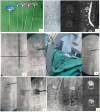Comparison of the efficacy of bilateral approach PVP and lateral hole injection combined with modified fluoroscopic unilateral approach PVP in the treatment of thoracolumbar osteoporotic fractures
- PMID: 40611119
- PMCID: PMC12224668
- DOI: 10.1186/s12893-025-02985-8
Comparison of the efficacy of bilateral approach PVP and lateral hole injection combined with modified fluoroscopic unilateral approach PVP in the treatment of thoracolumbar osteoporotic fractures
Abstract
Objective: To compare the clinical efficacy of bilateral approach PVP and lateral injection combined with modified fluoroscopic unilateral approach PVP in the treatment of thoracolumbar osteoporotic fractures.
Methods: The clinical data of 100 patients with thoracolumbar osteoporotic fractures who received treatment in our hospital from January 2018 to January 2021 were retrospectively collected. According to the different surgical methods, group A included 48 patients who received bilateral approach PVP. Group B was composed of 52 patients who received lateral injection combined with modified fluoroscopy. General data, intraoperative data, and postoperative follow-up data of the two groups of patients were collected and statistically analyzed.
Results: There was no significant difference in the general data between the two groups (P > 0.05), and the two groups were comparable. In terms of intraoperative data, the operation time of group B was shorter than that of group A, and the difference was statistically significant (P < 0.05). The number of intraoperative fluoroscopies in group B was less than that in group A, the difference was statistically significant (P < 0.05), while patients in group A had a higher bone cement leakage rate, and the difference was statistically significant (P < 0.05). In terms of postoperative follow-up, there was no statistically significant difference in VAS and ODI scores 1 day before surgery between the two groups (P > 0.05), and statistically significant difference in VAS scores 1 day after surgery, 1,3 and 6 months after surgery between the two groups compared with 1 day before surgery (P < 0.05). The ODI scores 1,3 and 6 months after surgery were statistically significant compared with 1 day before surgery (P < 0.05), while the VAS and ODI scores of the two groups were not statistically significant 1 day after surgery and 1,3 and 6 months after surgery (P > 0.05).
Conclusion: Compared with the bilateral approach PVP, lateral injection combined with improved fluoroscopy has the advantages of shorter operation time, fewer intraoperative fluoroscopy times, and lower bone cement leakage rate.
Keywords: Osteoporosis; Percutaneous vertebroplasty; Vertebral fracture.
© 2025. The Author(s).
Conflict of interest statement
Declarations. Ethics approval and consent to participate: This study has been approved by the Ethics Committee of the First Affiliated Hospital of Wannan Medical College. This study complies with the Helsinki Declaration. This study obtained informed consent from all participants. Consent of publication: Written informed consent for publication was obtained from all participants. Competing interests: The authors declare no competing interests.
Figures

Similar articles
-
Unilateral and Bilateral Percutaneous Vertebroplasty for Thoracolumbar Osteoporotic Vertebral Compression Fracture with Distant Lumbosacral Pain: A Single-Center Retrospective Analysis.World Neurosurg. 2025 Mar;195:123687. doi: 10.1016/j.wneu.2025.123687. Epub 2025 Feb 3. World Neurosurg. 2025. PMID: 39824383
-
The effectiveness of Valsalva Maneuver-Assisted percutaneous vertebroplasty in reducing cement leakage in osteoporotic vertebral compression fractures.BMC Musculoskelet Disord. 2025 Jul 16;26(1):688. doi: 10.1186/s12891-025-08840-4. BMC Musculoskelet Disord. 2025. PMID: 40670980 Free PMC article.
-
Two different unilateral percutaneous vertebroplasty approaches for acute osteoporotic vertebral compression fractures: clinical and radiological outcomes.BMC Musculoskelet Disord. 2025 Jul 4;26(1):628. doi: 10.1186/s12891-025-08887-3. BMC Musculoskelet Disord. 2025. PMID: 40615843 Free PMC article.
-
Therapeutic Efficacy and Safety of Percutaneous Curved Vertebroplasty in Osteoporotic Vertebral Compression Fractures: A Systematic Review and Meta-Analysis.Orthop Surg. 2023 Oct;15(10):2492-2504. doi: 10.1111/os.13800. Epub 2023 Jul 27. Orthop Surg. 2023. PMID: 37497571 Free PMC article.
-
Advantages of unilateral percutaneous kyphoplasty for osteoporotic vertebral compression fractures-a systematic review and meta-analysis.Arch Osteoporos. 2024 May 15;19(1):38. doi: 10.1007/s11657-024-01400-8. Arch Osteoporos. 2024. PMID: 38750277
References
-
- Zhang H et al. The puncture methods of extrapedicular PVP (PKP): A narrative review. Interdisciplinary Neurosurg, 2021. 25.
Publication types
MeSH terms
Substances
LinkOut - more resources
Full Text Sources
Medical

